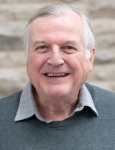Martin J. Stillman

Contact Information
Title: Professor
Office: Rm 064 ChB,
Labs: 051, 052 055, ChB
Phone (Office): ext 83821
Phone (Lab): ext 86358
E-mail: stillman@uwo.ca
Inorganic Teaching Division
Chemical Biology and Biomaterials
Mechanistic and electronic structure studies of bioinorganic systems. Studies using electrospray ionization mass spectrometry, magnetic circular dichroism, emission and emission lifetime techniques of metal-binding to proteins, porphyrins, heme proteins, the Isd proteins in Staphylococcus aureus, and metal-induced protein folding in metallothioneins.
Education
Ph. D. University of East Anglia (Norwich, UK); PDF University of Alberta, Canada
RESEARCH
The general theme of using mass spectral, optical and NMR spectroscopic data to obtain mechanistic, functional, structural, or electronic state information for molecules of bioinorganic interest. Our research encompasses all aspects of the roles of metals in biology and of porphyrinoid electronic properties.
Metal binding properties of the protein metallothionein, using electrospray mass spectrometry, XAS, metal-NMR, EPR, circular dichroism and emission spectroscopy to determine speciation as the protein binds the metals As, Cd, Hg, Ag, Cu, and Au. Formation of Cu12-MT, Ag12-MT, Ag18-MT, Hg7-MT and Hg18-MT have been reported. The mechanism for As(III) binding reported in 2006, represented the first kinetic analysis for a multi-metal-binding protein. Multi-domain proteins with biotechnological properties. Extensive use of molecular modelling provides an understanding of the spectroscopic data. Studies of Bi(III) binding to metallothioneins from the kidneys, liver and brain reveal a rich chemistry.
The redox and spectroscopic properties of phthalocyanines and porphyrins. Effects of symmetry-reduction through both peripheral substitution and porphyrin-ring folding. Electronic properties of porphyrinoids, to determine the electronic distribution and the effect on chemical properties. Calculations of the electronic structures of very large ring compounds to allow future prediction of chemical and physical properties see for example A Zhang, MJ Stillman (2018) “Exploring function activated chlorins using MCD spectroscopy and DFT methods: design of a chlorin with a remarkably intense, red Q band”. Physical Chemistry Chemical Physics 20 (18), 12470- 12482. DOI:10.1039/C8CP01010B
Identifying methods to overcome antibiotic resistant S. aureus in humans. Studies of the iron-containing heme binding properties of a series of proteins located on the outer wall of the pathogenic bacterium, Staphylococcus aureus to discover means of overcoming the increasingly disturbing antibiotic resistance in S. aureus (MSRA) now in the general population. In 2008, we reported the first evidence that heme can be shuttled between the Isd proteins. See for example: Tiedemann, M.; Heinrichs, D.E.; Stillman, M.J. (2012) “Multi-protein heme shuttle pathway in Staphylococcus aureus: Isd cog-wheel kinetics”, J. Am. Chem. Soc. 134, 16578-16585. DOI: 10.1021/ja305115y.
TEACHING
- 2211 - Metals in Life
- 3371 - Transition Metal Chemistry
- 3391 - Bioinorganic Chemistry
- 4441 - Inorganic Polymers
- 4491 - Research Project
- 9658 - Topics Seminar
- 9621 - Methods of Bioinorganic Chemistry
SELECTED PUBLICATIONS
-
A Melenbacher, L Heinlein, A Hartwig, MJ Stillman (2023) “63Cu(I) binding to human kidney 68Zn7-βα MT1A: determination of Cu(I)-thiolate cluster domain specificity from ESI-MS and room temperature phosphorescence spectroscopy” Metallomics, vol 15, mfac101 doi.org/10.1093/mtomcs/mfac101
-
AT Yuan, NC Korkola (2023) “Apo-metallothionein-3 cooperatively forms tightly compact structures under physiological conditions” J Biol. Chem. 102899 doi.org/10.1016/j.jbc.2023.102899
-
NC Korkola, E Hudson, MJ Stillman (2021) “Structurally restricted Bi (III) metallation of apo-βMT1a: metal-induced tangling” Metallomics 13 (5), doi.org/10.1093/mtomcs/mfab023
-
A Melenbacher, NC Korkola, M Stillman (2020) “The pathways and domain specificity of Cu (I) binding to human metallothionein 1A”, Metallomics, 12 (12) 1951-1964. DOI.org/10.1039/D0MT00215A.
-
AT Yuan, NC Korkola, DL Wong, MJ Stillman (2020) “Metallothionein Cd 4 S 11 cluster formation dominates in the protection of carbonic anhydrase” Metallomics, 12, 767-783 DOI: 10.1039/D0MT00023J.
-
DB Ott, A. Hartwig, MJ Stillman (2019) "Competition between Al3+ and Fe3+ binding to human transferrin and toxicological implications: structural investigations using ultra-high resolution ESI MS and CD spectroscopy” Metallomics, 11 (5), 968-981 DOI: 10.1039/C8MT00308D

